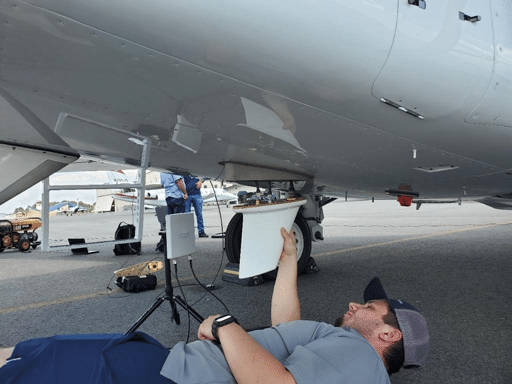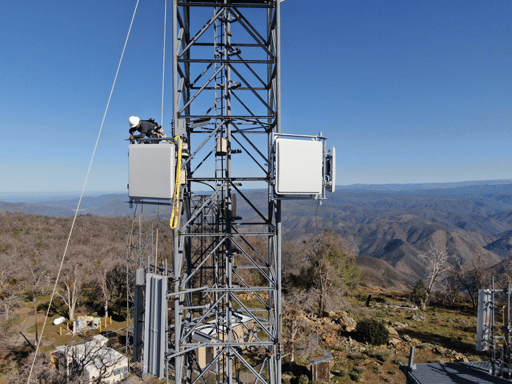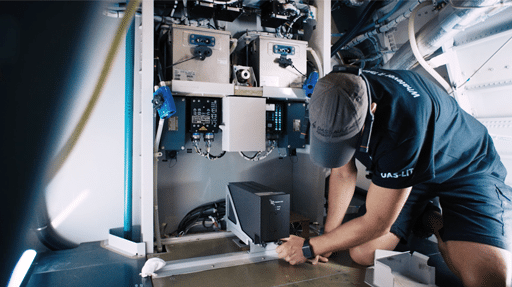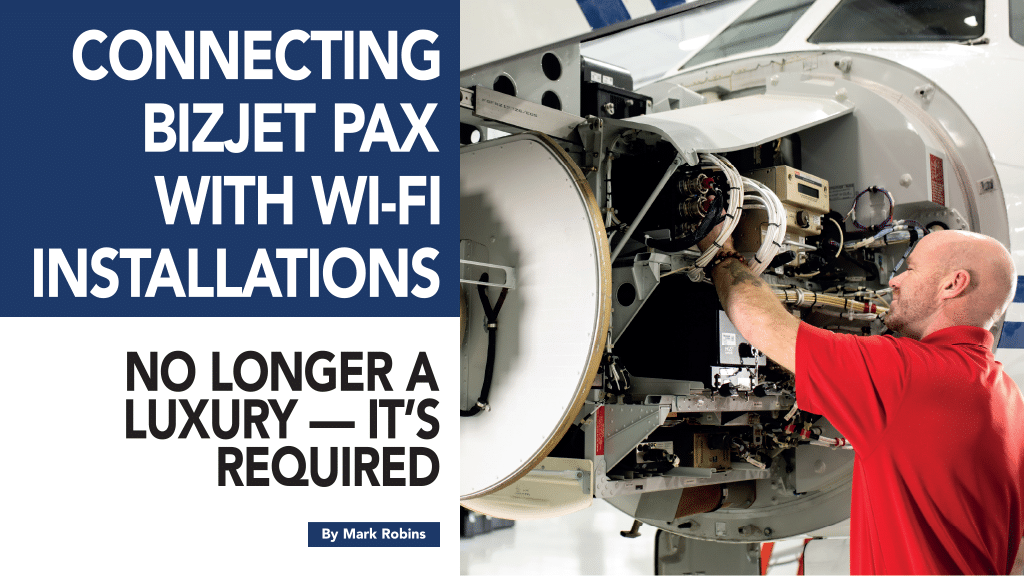To maximize in-flight productivity on private business jets, all eyes are set on optimizing Wi-Fi connectivity. With it, business jets are being turned into flying business headquarters. Passengers can stream content to their personal devices, surf the internet, send and receive email, use social networking and universal messaging, and even hold video conferences on their smartphones, tablets, laptops, or gaming devices. Here’s how that’s being done.
Air-to-Ground Wi-Fi
With air-to-ground (ATG) Wi-Fi network, a business jet works as a hotspot that passengers connect to. The signal is transmitted from cell towers located on the ground to the aircraft in the sky, and vice versa.
The benefits of air-to-ground service include: the size and weight of equipment is smaller and lighter than traditional geostationary (GEO) satellite systems, equipment and installation costs are lower than GEO equipment, and much lower latency. Latency is the delay that occurs when data is sent from the aircraft to the network because ground networks are much closer (40,000 feet or less) compared to GEO satellites which are 22,000 to 25,000 miles from earth.
“It’s a matter of physics, it takes longer for the signal to travel thousands of miles versus thousands of feet,” says Dave Mellin, director of communications for Gogo Business Aviation, Broomfield, Colo. “What that means is there are no delays waiting for the signal to travel with ATG and that makes using services like video conferencing (Microsoft Teams, Zoom) work well versus GEO satellite systems where there are delays which make video conferencing or even simple voice conversations difficult.”
The downside to ATG networks is they are limited currently to North America for many companies. “ATG delivers a very specific service that is limited by the presence of the ground towers, which immediately restricts operating range,” says Michael Skou Christensen, CCO, Satcom Direct, Melbourne, Fla. “Yes, there is a price advantage, but low fees are not necessarily an advantage in this space. People fly in private jets because their time is precious, not because they are cheap transport options and increasingly, passengers want to use more data to use more applications on more devices. When they fly, they want great connectivity all the time, no matter where they are travelling. ATG is unable to support that growing need.”
Satellite Wi-Fi
The main advantage of satellites (satcom) is that they can reach almost any point on the globe, including over the poles and oceans. It uses a satellite geostationary orbit to connect users to the internet. The Wi-Fi signal is available to passengers through an onboard router. This is usually the most expensive form of Wi-Fi, but it’s also the most efficient. Typical ATG Wi-Fi speeds range from around 3 to 10 Mbps, while satellite systems for aircraft now offer between 30 Mbps and 100 Mbps.
Christensen explains, “It is not surprising to see some of the ATG players transitioning to the satcom space and trying to develop flat panel antennas. They do not have the experience and are already having to rethink their designs. The satellite airtime that is supported by our Plane Simple antenna series is bringing a range of affordable, easily upgradeable, easy-to-install solutions — just two-line replaceable units are all that’s needed — our SD modem unit and the antenna — to deliver high-speed data.”
When comparing ATG and satellite-based internet systems, each type of system has benefits and disadvantages. Satellite systems can be further broken down into two main categories, GEO or Geosynchronous Earth Orbit and LEO or Low Earth Orbit. Again, ATG systems typically cost much less to purchase and install than most satellite systems.
“Another benefit of ATG systems is their ability to be installed on a larger variety of aircraft due to their smaller installati≠≠on footprint, although newer satellite antenna technologies are reducing their footprint as well,” Rich Pilock, vice president of product management, SmartSky Networks, Morrisville, N.C. “When it comes to performance, there are many differences between the systems. Both ATG and LEO systems typically have very low latency when compared to GEO systems, which is critical for real-time applications. Satellite systems in general can provide much more bandwidth to the aircraft than ATG systems, but typically provide very little bandwidth to move data off the aircraft, which is very important for customers.”

Installation
ATG systems utilize small antennas mounted on the belly of the aircraft, while satellite systems utilize larger antennas mounted in the tail or on the top of the aircraft. Equipment configurations will vary but as an example, Darren Emery, vice president of customer operations at SmartSky Networks says the SmartSky system utilizes a single line-replaceable unit (LRU) radio to provide the interface to the antennas and the cabin system. “In the case of a satcom system, additional LRUs may be required with beneath-radome (a weatherproof housing for the antenna), or separate power and modem equipment. Both systems share similarities in equipment by providing cabin Wi-Fi connectivity for passenger and crew use via one or more cabin wireless access points/routers, depending on the size of the aircraft.”

Costs will vary depending on factors including the type of system, the aircraft size, and whether other work is being completed during the installation, but for an ATG Emery says the out-the-door price varies between $100K and $200K. A typical satellite system installation may cost double or triple this amount.
Overall installation complexity varies by system, but a wide range of MROs and OEMs are familiar with connectivity solutions and can provide minimal downtime for installation for less complex systems. A maintenance interval provides a great time to bundle potentially cost-saving maintenance and connectivity upgrades when areas of the aircraft may be exposed for maintenance tasks.
“When considering a new connectivity system or upgrading an existing system, users should consider the total installation requirements to reach the intended connectivity goal,” says Emery. “Some systems may require multiple LRUs, or a further update path in the future to receive a next-gen capable performance. Those installing a new system should consider the total cost of ownership. While the installation cost may be attractive depending upon the overall installation scope, factor in the overall monthly service costs over say, five years, along with the level of performance you are seeking. An overall total cost of ownership calculation can provide surprising results and demonstrate tangible overall savings, particularly for a next-generation ATG system.”
ATG systems typically require just one LRU, sometimes two, and they are small and can be placed anywhere inside the aircraft. Because of their smaller size and weight, Mellin says they can also be installed on small aircraft including GA aircraft such as the Cirrus Vision Jet (Gogo AVANCE L3 is a factory option on the Vision Jet), as well as super light jets and turboprops on up to long-range heavy-iron jets. “ATG systems use small antennas mounted on the belly of the aircraft. GEO systems are larger and heavier, usually require more than two LRUs, which are larger, and the antennas they use are large so they can only fit on large aircraft. The antennas are typically mounted in the tail of the aircraft. For LEO systems, they use electronically-steered antennas (ESAs) that are mounted on the fuselage. Gogo’s LEO system, called Gogo Galileo, requires just one antenna, one Gogo AVANCE LRU and one wire for power in and another for Ethernet, so installation is relatively simple compared to GEO systems. Gogo Galileo comes with two antenna options.”
Connectivity Challenges
There are several different challenges for Wi-Fi connectivity on business jets: weight of antennas, size of aircraft, the number of users in an aircraft and their expectations, as well as physics.
Christensen explains that increasingly in-flight connectivity is compared with the terrestrial experience, characterized by a consistent, high bandwidth, low latency connection. “Replicating this experience in an aircraft that is constantly altering course, flying at 45,000 feet at nearly 0.9 Mach, is a technical challenge. The antenna and satellite are both in motion, obstacles, such as clouds or rain, can affect latency depending on where the aircraft is, the airtime provider and the antenna used.”
Mellin explains that the keys to overcoming connectivity challenges and providing quality Wi-Fi service on business jets include: coverage, capacity, connection and consistency. “Coverage needs to be sufficient to ensure no breaks as the signal moves from tower to tower or from satellite to satellite. There must be enough capacity to support multiple aircraft in a given area so the signal doesn’t degrade even in high-traffic area. Connection is done using quality antennas and networks that communicate seamlessly even when traveling at 500 mph at 35,000 feet, and in extreme environments where temperatures fluctuate from -55 degrees Celsius (-67 Fahrenheit) to 85 degrees Celsius (185 Fahrenheit). Consistency is achieved through the combination of all the above working well continuously together. The systems also need to keep up with the latest developments in technology and evolve as those occur. Gogo AVANCE is a platform, not a product, and it is designed to be updated continuously as technology evolves without needing to replace the onboard equipment, and AVANCE can accommodate multiple networks with its multi-bearer capability.”

The aviation environment is challenging because business jets are flying 500 mph at 41,000 feet. Every time the aircraft moves in any direction, Pilock says the systems need to react to those changes to maintain their connections. “All of the systems have that capability built in, but many variables impact the quality of the service. As an aircraft transitions from one beam or tower to another, the systems must work quickly and efficiently to maintain a high quality connection. Within the cabin, the providers must ensure that the wireless network is configured correctly with minimal interference so that every passenger has a great experience.”
Christensen adds that a connectivity challenge is space availability; the size of the antenna and space in the aircraft as traditional tail-mount terminals may have up to six system boxes. “These have generally been placed in the baggage compartment taking up valuable space. Antennas need to fit into the radome on the tail, which is why it’s only been possible for large cabin aircraft to access the technology. So yes, the larger the jet, the easier it has been to install Wi-Fi with minimal compromise. However, the SD Plane Simple terminals have been designed to fit into the unpressurized part of the aircraft, so they do not take up valuable cabin space. Equally, the ESA flat panel is designed to fit onto the fuselage of smaller aircraft. This means that even the smaller jets can benefit from Wi-Fi installations with minimal invasion of the cabin space. It’s a revolution for this class of airframe in terms of access to connectivity.”
What’s Different About Business Jets?
Both business jets and commercial passenger airplanes rely on very similar technologies to provide internet service to passengers. In many cases they even utilize the same satellite systems to make their connections. “The biggest differences lie in how they provide the service to the passengers within the cabin,” Pilock says. “Since most airlines provide some sort of entertainment on board as well, they have more infrastructure such as media servers for access to stored content as well as many more wireless access points to support more users.”
Christensen explains the needs of the business jet customers are different than the commercial sector, which is why Satcom Direct developed a Wi-Fi connectivity system built for this sector. “In the business aviation world, if the connectivity is not working it is considered an AOG, and the aircraft is likely to be grounded until a solution is sourced. It is not a revenue-generating mechanism or a differentiator between cabins, it is an expectation, so the hardware needs to be robust, and provide consistent connectivity and function wherever the aircraft is in the world. It is a very different proposition to the commercial offering.”
Derek Zimmerman, president, Gulfstream Aerospace customer support, Savannah, Ga., says the biggest differences between business jet cabin versus passenger airplanes are the airframe geometry, passenger count and optimization that is based on the difference in size and scale between these two market segments. “The commercial marketplace has larger airframes and passenger counts, typically resulting in a single fuselage-mounted antenna. The passengers usually change every flight and therefore the service must provide a consistent standard for multiple and generic uses. In our world, the different configurations of a business jet better lend itself to one or more tail-mounted antennae. The passenger counts are lower, and the needs of individual passengers are better defined. This allows both the service and the installation to be tailored to the specific devices, applications, and users that are connected to the aircraft. This includes an expanding suite of on-ground and in-flight tools to manage and prioritize network performance and cybersecurity.”
Upgrades to Business Jet Wi-Fi
Connectivity to the aircraft, and within the aircraft to onboard devices, has matured over the past decade. While the installation itself is now relatively straightforward, traditionally each service provider delivered a customized solution, often leveraging hardware developed for different markets (ex. Maritime, commercial aviation, etc.). Zimmerman says a by-product of this approach was that each service required considerable downtime and expense to certify, replace and retrofit each new installation. He adds that this made the upgrade path difficult and costly, which wasn’t a sustainable solution.
Zimmerman says Gulfstream has been working with its key partners to include satellite operators, hardware manufacturers and service providers to help the industry transition to more “network agnostic,” and therefore reusable, product designs that are purpose-built for business aviation. “The goal is to offer a consistent, common architecture that allows for easier service selection and upgrade paths through replaceable modules or software revision. This approach will also allow operators to leverage multiple network sources to deliver the best possible coverage, performance, redundancy and service flexibility.”
In terms of upgradability, Emery says the average life of an onboard system can be 17 years or more, and that lifecycle depends on how long you are willing to live with older technology than what is available on the market at any given point. “In the electronics world, many times by the time you purchase a system, a newer version is out. For that reason it is beneficial to select a system that is software defined. That means you can upgrade to the latest version and newest capability without having to install new equipment. This extends the life and performance of your investment for many years. SmartSky’s innovative hardware includes software-defined radios on the aircraft and on the network. They currently use a combination of 5G and LTE technologies and customers will be able to take advantage of the next ‘G’ when it comes along without additional hardware investment.”
Every aircraft is unique as is the mission of the aircraft. Mellin explains the system you choose needs to be looked at through that lens: “What is the mission of the aircraft? Where does it fly (North America, globally)? What size is the aircraft? What is your budget for the system, installation, and monthly service? How many people will be on board and what do they need in-flight Wi-Fi for (lighter use like internet browsing and email, or more robust requiring high-speed connections with low latency like video conferencing, video streaming, gaming, large file transfers, etc.)? If you look at the options available using those criteria you can find the best solution for your needs.”

Future
Looking to the future of business jet Wi-Fi connectivity, Zimmerman expects upcoming products to deliver access to more satellite constellations, including both GEO and LEO networks, along with faster speeds, increased bandwidth, reduced latency, and more comprehensive and flexible service offerings from existing networks.
